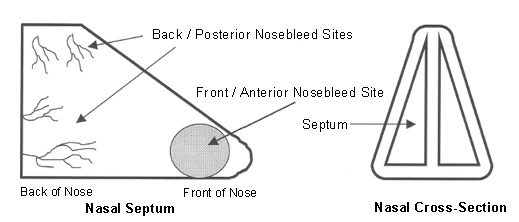Patient discussions
Provide patient education, such as printed handouts. Typical information includes:
Details on the causes of nosebleeds
Basic nasal anatomy, including the fact that most nosebleeds arise from the front of the nose
Advice on home treatment of nosebleed: squeeze the nostrils together while sitting upright for 20 minutes, then use moisturising techniques
A summary of the medical treatment of nosebleeds
Advice concerning care for the nose after treatment.
[Figure caption and citation for the preceding image starts]: Diagram of bleeding sites in nose to accompany written patient informationProduced by David A. Randall, Springfield Ear Nose Throat and Facial Plastic Surgery, MO [Citation ends].

Advice on care for the nose following treatment includes the following:
Petroleum jelly: may be applied to the front of the septum, inside the nostril, with a cotton-tipped applicator or a finger, 4 times daily for about 3 weeks
Saltwater nasal spray: may be purchased in pharmacies or similar stores and sprayed into the nose throughout the day to keep it moist
Humidifier: placing a humidifier near the bed helps to prevent drying at night
Minor bleeding: may be expected during the initial healing period; patients may self-treat with pressure and topical decongestants
Nasal decongestant spray: may be sprayed on to a small cotton wool ball and placed on the bleeding area for 10 to 15 minutes, if bleeding recurs at the front of the nose
Avoidance of aspirin or non-steroidal anti-inflammatory drugs and other anticoagulant medicines: for 3 to 4 weeks as medically appropriate
Trauma: avoidance of vigorous nose blowing, rubbing, or picking during healing
Follow-up: recommended on an as-needed basis only, so long as there are no continued problems.
This advice is appropriate for all epistaxis situations, whether or not there has been any treatment. Similarly, liberal moisturisation during dry, cold months may reduce the frequency of epistaxis in patients with a history of this problem. Encourage patients to keep information available for future reference.
Use of this content is subject to our disclaimer